
No matter your role in an organization, developing a strong leadership presence is key to success. Being able to effectively communicate your ideas and motivate others will help you reach your goals and positively impact your team.
Related Course: Leadership Training Course
Leadership presence is a powerful tool in any leader’s arsenal. Of course, it requires dedication, hard work, and consistency to develop, but the benefits are worth it!
The importance of leadership cannot be understated as well - Without someone leading, their team members can become stale or, worse yet- defeated by circumstance (or even another company). Recognize your strengths to know what areas need improvement before looking outside yourself for answers; there should always be balance within each person who works with you.
Leadership presence results from many factors, some more important than others. The most important factor is undoubtedly your own attitude and outlook towards life. If you’re positive and upbeat, your team will be as well! Other important factors include:
Your ability to communicate effectively
Your body language
Your ability to listen
Your ability to empathize with others
These factors play an essential role in your leadership presence, but remember that attitude is critical. A positive attitude will reflect in all other aspects of your leadership presence and carry you through even the most demanding challenges!
What does leadership presence mean?
Leadership presence is the ability to communicate effectively and inspire others to achieve their goals. It’s about having a clear vision and articulating it in a way that motivates others to take action.
The Most Important Key to Leadership Success: Emotional Energy Management
Unlocking Niches: Divisional Structure for Successful Corporations
Building Strategic Relationships Making a Smooth Executive Transition
It’s also essential to be able to listen to others and build consensus. A strong leader can bring people together and get them working towards a common goal.
Finally, it’s essential to be able to handle stress and adversity. Leaders need to stay calm under pressure and make decisions quickly. They also need to be able to bounce back from setbacks and learn from their mistakes.
Developing your leadership presence takes time and effort, but it’s worth it. These skills will help you be successful in any organization.
Importance of leadership presence in the workplace
Leadership presence in the workplace can have a significant impact on organizational success. A leader with a strong presence can inspire and motivate employees. In contrast, a not present leader can create an environment of apathy and disengagement.
When leaders are present in the workplace, they are visible and accessible to employees. This allows them to build relationships and trust with their team members. In addition, employees feel valued and appreciated when their leaders take the time to interact with them personally.
Leaders who are present in the workplace can also provide clear direction and guidance. They can help employees understand the company’s goals and how their individual roles fit into the larger picture. This clarity can lead to greater engagement and motivation among employees.
Leaders present in the workplace can serve as role models for employees. Their behavior and actions can set the tone for the entire organization. When leaders display positive behaviors, such as integrity and respect, employees are more likely to follow suit.
The presence of strong leadership in the workplace is essential to organizational success. Leaders who are present and engaged with their employees can create a positive work environment, provide clear direction, and serve as role models for positive behavior. These factors all contribute to increased productivity and overall success. Therefore, organizations need to foster a culture of leadership presence to achieve their goals.
Tips for developing your leadership presence
Here are 24 tips for developing your leadership presence.
1. Understand what leadership presence is and what it isn’t.
Leadership presence is about just looking at the part or sounding confident. It’s a combination of factors that create an overall impression of authority, credibility, and competence.
2. Practice your body language
Body language is a powerful tool that can communicate a lot about your feelings. As a leader, it’s essential to be aware of your own body language and the non-verbal cues of those around you.
3. Make eye contact.
When speaking to someone, make sure you make eye contact – it’s a critical element of projecting confidence. Avoid looking down or around the room, and try to maintain eye contact at least 60% of the time.
4. Speak slowly and clearly.
When you’re speaking, take your time and enunciate your words clearly. Avoid rushing your words or speaking too quietly – both can make you seem nervous or uncertain.
5. Use power language.
The words you use can also impact how confident and authoritative you sound. Use strong, positive language that conveys certainty and conviction. For example, instead of saying “I think” or “maybe,” try using phrases like “I know” or “definitely.”
6. Dress the part.
How you dress also contributes to your leadership presence. Make sure you’re well-groomed and wearing appropriate clothes for the situation and convey confidence.
Pay attention to how you dress! The way you dress sends a message about who you are and what you stand for. As a leader, it’s essential to be mindful of the image you’re projecting to those around you.
7. Be aware of your tone.
Your tone of voice is another important factor in coming across to others. Avoid sounding monotone or robotic – instead, try to communicate warm and interested. And, when appropriate, use humor to build rapport and put people at ease.
8. Keep your emotions in check.
To project confidence, it’s essential to keep your emotions in check. Avoid appearing angry, anxious, or stressed – instead, focus on appearing calm and collected. If you feel nervous or uncertain, take a few deep breaths to help yourself relax.
Develop your emotional intelligence! Emotional intelligence is the ability to be aware and understand emotions and manage them effectively. This is a critical skill for any leader, as it can help you better understand and relate to those around you.
9. Listen more than you speak.
One of the best ways to project confidence is to listen more than you speak. When you’re in a conversation, resist the urge to dominate – instead, let the other person do most of the talking. This will make them feel good, but it will also give you time to gather your thoughts and form a response.
Engage people! One of the most important aspects of being a leader is engaging with those around you. This means being present and available to listen, learn, and collaborate.
So it means to communicate effectively! Effective communication is essential for any leader. This includes being able to clearly articulate your vision and listening and responding to feedback.
10. Use affirmative statements.
When you’re speaking, use affirmative statements rather than questions. For example, instead of saying, “Are you sure?” try saying, “That sounds like a great idea!” This will make you sound more confident and sure of yourself.
Read and adapt to different situations! Leaders need to be able to read and adjust to other conditions quickly. This includes being able to understand both verbal and non-verbal cues and being flexible in your approach.
11. Be prepared.
One of the best ways to project confidence is to be prepared. If you know what you’re talking about and feel confident in your ability, it will show in your demeanor. So take the time to do your research and prepare for whatever situation you face.
12. Practice assertiveness.
To project confidence, it’s essential to be assertive – not aggressive. This means standing up for yourself and speaking up when necessary but doing so in a way that doesn’t come across as confrontational or disrespectful. If you’re unsure how to strike the right balance, consider attending an assertiveness training course.
13. Avoid filler words.
When you’re speaking, avoid using filler words like “um,” “like,” “you know,” and “actually.” They make you sound nervous, but they also take up valuable time that you could be using to make your point.
14. Be aware of your energy level.
Your energy level is another critical factor in coming across to others. If you’re tired or low on energy, it will show in your voice and body language. So make sure you get enough sleep and eat healthy meals to keep your energy up.
15. Speak from experience.
When you’re sharing your ideas, be sure to speak from experience. This will give you more credibility and make you sound more confident.
16. Use positive body language.
Your body language plays a significant role in how you come across others. For example, avoid crossing your arms or legs, making you seem defensive or unapproachable. Instead, try to keep an open posture and make eye contact.
Keep a positive attitude. A positive attitude is contagious and can be instrumental in maintaining a positive work environment. Additionally, it’s essential to model the behavior you want to see in others.
17. Take up space.
When you’re in a meeting or presentation, make sure you take up enough space. This means standing up straight and avoiding fidgeting – it will make you appear more confident and in control.
18. Make decisions quickly.
When you’re in a position of authority, it’s essential to make decisions quickly. If you hesitate or take too long to make a decision, it will make you look weak and uncertain.
19. Be decisive.
In addition to making decisions quickly, it’s also essential to be decisive. This means being firm in your convictions and not changing your mind quickly – if you do, it will make you look indecisive and unreliable.
20. Belief in yourself.
Above all else, it’s essential to believe in yourself. If you don’t think you can do something, it will be complicated to convince others that you can. So build up your self-confidence and remember that you can achieve great things.
21. Motivate others.
As a leader, one of your most important jobs is motivating others. This may involve setting goals, providing incentives, or simply being a positive role model
22. Improve your confidence.
Confidence is critical in any leadership role. If you’re not confident in your own abilities, it will be challenging to gain the trust and respect of those around you.
23. Cultivate a positive work environment.
A positive work environment is essential for both productivity and morale. As a leader, you can cultivate this environment by promoting open communication, encouraging positive reinforcement, and setting the tone for the team.
24. Help teams accomplish goals.
As a leader, part of your job is to help others achieve their goals. This may involve setting the vision for the team, providing resources or support, and offering guidance along the way.
How to develop leadership presence skills
As a result, leadership presence is the ability to inspire confidence and trust in others. It is the capacity to project calm and authority, even in chaos. Leadership presence cannot be learned from a book or acquired through training; it is an art that must be developed through practice and experience. In today’s fast-paced world, leadership presence is more important than ever. With so much uncertainty and change, people are looking for leaders who can provide stability and direction. Those who have a leadership presence can instill confidence in others and help them navigate difficult times. Although leadership presence is not easy to define, it is an essential quality for any leader who wants to be successful. Leadership is an art, not just a skill.
Leadership presence is the ability to project confidence and authority. It takes time and effort to develop, but it’s worth it. These tips will help you get started on the right foot and positively impact those around you.
Start by paying attention to your posture and your breath. Stand up straight and take deep breaths from your diaphragm. This will help you project confidence and calmness. Speaking slowly and evenly will also help you project authority. Make sure to articulate your words clearly and without pauses or “um” s.
It’s also important to be aware of your nonverbal communication. Your facial expressions, eye contact, and gestures all play a role in leadership presence. Make sure you make eye contact with those around you and use open, welcoming body language. Smiling is also a crucial part of leadership presence – it makes you seem approachable and trustworthy.
This may seem like a lot to remember, but don’t worry – leadership presence comes with practice. The more you focus on it, the easier it will become. And soon enough, you’ll be exuding confidence wherever you go!
The online leadership course at IIENSTITU can provide you with the skills and knowledge to take your leadership abilities to the next level. Through interactive learning modules and expert-led training, you’ll develop an understanding of what it takes to be a successful leader. You’ll learn to communicate effectively, build trust and consensus, and create a vision for your team or organization. In addition, you’ll discover techniques for managing conflict and motivating others. By the end of the course, you’ll have the tools you need to make a real difference in your workplace or community.
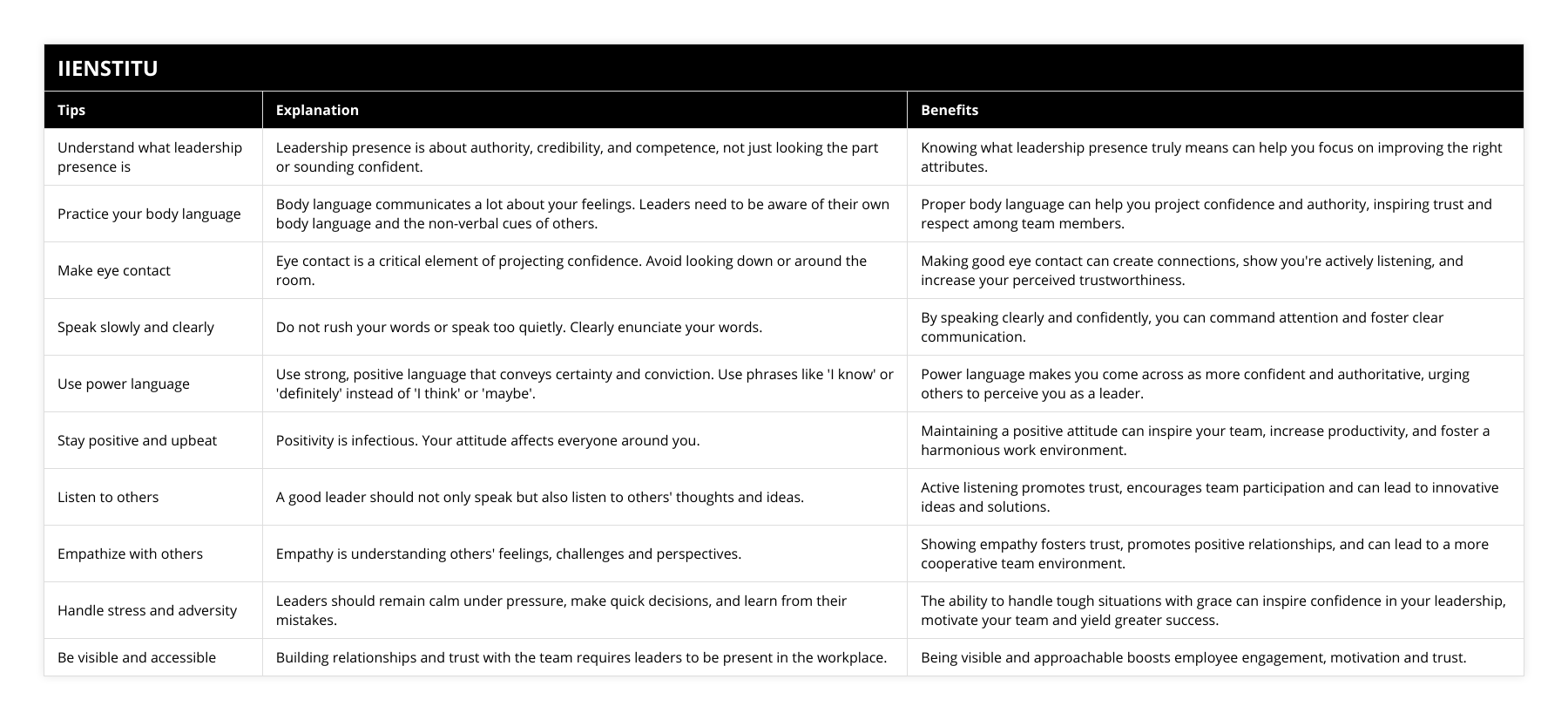
Frequently Asked Questions
What does leadership presence mean?
Leadership presence is the ability to project power, confidence and intelligence through posture, gestures, vocal delivery and eye contact. It's often described as "the X factor" that separates great leaders from good leaders.

What is the importance of leadership presence in the workplace?
Leadership presence is said to be the ability to project an air of confidence, authority, and composure in both verbal and nonverbal communication. Leadership presence is essential in the workplace because it helps inspire trust and respect among employees. It also helps to create a sense of stability and certainty, which can be especially important during stress or uncertainty.
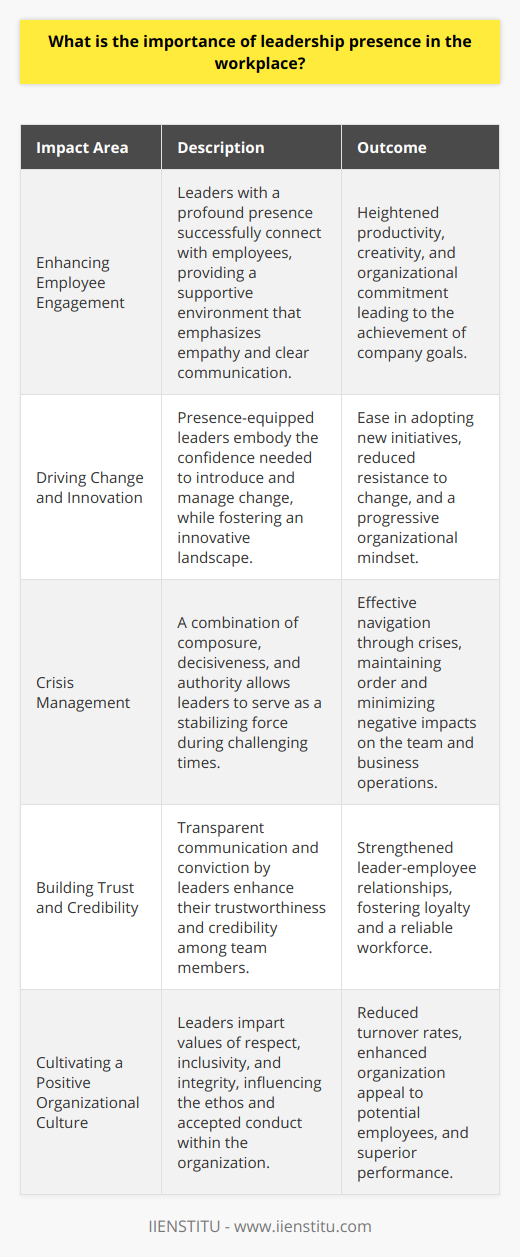
What leadership presence should you have?
The best leaders are those who exude confidence and competence. They have a clear vision for where they want to take their team, and they possess the skills and drive to get there. They also inspire others to follow them by example and through persuasive communication.
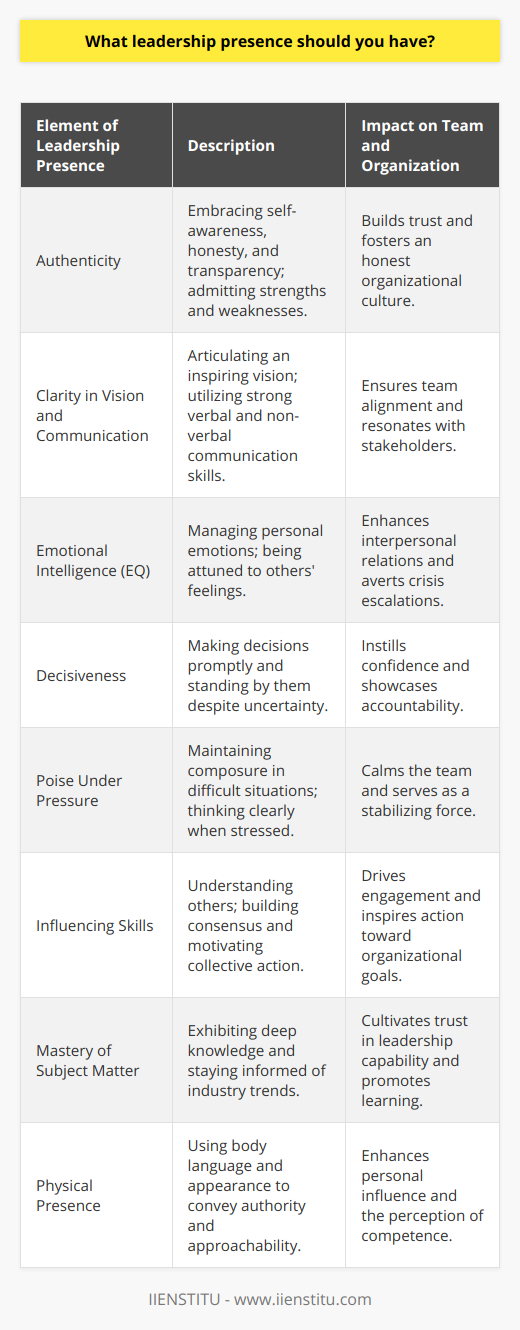
What are the 5 C's of leadership presence?
### Introduction
Leadership presence is an essential quality for those who wish to lead and make an impact in their chosen field. According to researchers, the five Cs of leadership presence are confidence, credibility, connection, charisma, and communication. These five essential elements play a critical role in determining the success of a leader.
### Confidence
Confidence refers to a leader's self-assurance and belief in their abilities to achieve goals and overcome challenges. A leader with confidence can inspire trust and foster a sense of security among team members, which encourages them to take risks and work together to achieve the desired results.
### Credibility
Credibility involves a leader's ability to demonstrate expertise, integrity, and trustworthiness. Leaders with credibility are perceived as reliable and honest, which motivates employees to follow their guidance and strive for excellence. Moreover, a credible leader's actions align with their words, reinforcing their authority and respect among colleagues.
### Connection
Establishing connections with team members is crucial for leaders, as it helps to create a supportive and inclusive work environment. Connection involves demonstrating empathy, active listening, and understanding the needs, motivations, and aspirations of team members. A strong connection fosters loyalty, collaboration, and respect, leading to a more productive and engaged workforce.
### Charisma
Charisma encapsulates a leader's ability to inspire, motivate, and engage others. Leaders with charisma can spontaneously capture the attention and admiration of their employees, making them more receptive to new ideas and change initiatives. Charismatic leaders energize others with their future-oriented vision, instilling a sense of purpose and ambition within their team.
### Communication
Effective communication is the cornerstone of leadership presence. A proficient communicator can deliver clear and concise messages, adapt their communication style to different audiences, and express their expectations and feedback with clarity. Strong communication skills enable leaders to delegate tasks confidently, resolve conflicts, and keep team members informed, facilitating a more cohesive and collaborative work environment.
### Conclusion
In conclusion, the five Cs of leadership presence – confidence, credibility, connection, charisma, and communication – serve as a framework to evaluate and develop one's leadership abilities. By cultivating these qualities, individuals can enhance their effectiveness as leaders, fostering a more engaged and productive workforce, and driving the success of their organization.

How can I improve my leadership presence?
Enhancing Self-Awareness
To improve leadership presence, one must begin by enhancing self-awareness. Understanding your values, beliefs, and preferences is essential for discovering your authentic leadership style. Reflect on what traits you want to exude as a leader and recognize areas that require improvement.
Effective Communication
Communication is a critical aspect of leadership presence. Developing excellent verbal and non-verbal communication skills ensures that leaders can articulate their vision and expectations clearly, fostering collaboration and trust. Practice active listening and establish open channels for feedback.
Emotional Intelligence
Emotional intelligence is closely linked to leadership presence. By managing your own emotions and understanding the feelings of others, leaders can maintain strong relationships and minimize conflicts. Empathy and sensitivity are essential for generating a strong leadership presence and enhancing influence.
Confidence and Assertiveness
A strong leadership presence relies on demonstrating confidence and assertiveness. Leaders must believe in their abilities and be willing to make tough decisions. Maintaining poise under pressure and calmly asserting authority help solidify one's presence and command respect from others.
Body Language
Conveying presence is not only about what you say but how you say it. Pay attention to your body language, posture, and tone of voice when communicating. Maintain eye contact when speaking, stand tall, and project your voice to exude a sense of authority and competence.
Adaptability and Flexibility
Leaders with a strong presence are adaptable and flexible in various situations. This requires being open to different perspectives and willing to change course when necessary. By demonstrating versatility, you can connect with diverse groups and foster an inclusive environment.
Continuous Learning
Finally, continuously invest in your growth and development. Attend workshops, seminars, or conferences on leadership and take courses to enhance your skills further. This ongoing commitment to growth will not only improve your leadership presence but also inspire those around you to grow as well.
In conclusion, improving leadership presence involves a combination of self-awareness, effective communication, emotional intelligence, confidence, assertiveness, body language, adaptability, and continuous learning. By focusing on these elements and being authentic in your approach, you can cultivate a powerful leadership presence that positively influences and inspires those around you.
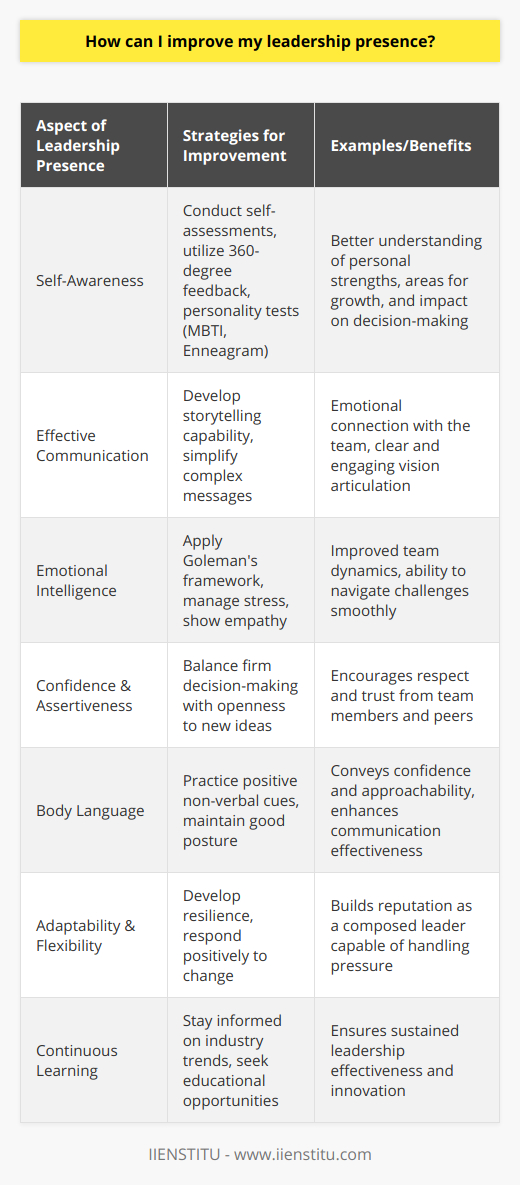
What are the 3 Ps of executive presence?
The Three Pillars of Executive Presence
**Perception**
The first P of executive presence stands for perception, which concerns the way a leader is viewed and judged by others. This aspect involves cultivating a positive image, demonstrating credibility, and showing confidence in one's abilities. It is crucial for an executive to be able to shape the opinions of others and inspire trust, as this helps in establishing authority and influence within the organization.
**Presentation**
The second P is presentation, which entails the way a leader exhibits their thoughts, ideas, and emotions. Excellent communication skills and the ability to articulate ideas concisely play an essential role in fostering this aspect of executive presence. Presentation is not only about verbal articulation but also includes non-verbal cues such as posture, gestures, and facial expressions. A strong presentation helps executives convey their messages effectively and persuasively, thereby enhancing their reputation and credibility.
**Performance**
The third P of executive presence stands for performance, which focuses on the ability of a leader to produce results and achieve goals. This aspect highlights the importance of consistently demonstrating competence and delivering on commitments. A track record of successful performance solidifies a leader's credibility and allows them to garner the respect and admiration of their colleagues and subordinates. Furthermore, executives with a strong performance record are more likely to be entrusted with critical responsibilities and higher levels of authority within the organization.
In summary, executive presence is a multifaceted concept that encompasses perception, presentation, and performance. These so-called '3 Ps' are interrelated and serve as critical building blocks for developing a powerful and effective leadership presence. To cultivate a strong executive presence, leaders must be mindful of how they are perceived, hone their communication skills, and showcase their ability to perform and achieve desired results consistently. By mastering these elements, leaders can leave a lasting impact and contribute significantly to the success of their organizations.

What are the 7 C's of executive presence?
Explanation of the 7 C's of Executive Presence
The first C: Composure
Executive presence begins with maintaining Composure under any circumstances. Leaders with firm composure can face challenges without panicking.
Understanding Confidence
In the context of executive presence, Confidence refers to a leader’s ability to project certainty in their decisions, skills, and team.
Clarifying Credibility
Credibility is next in line. A credible leader exudes honesty, reliability, and integrity, thereby gaining the trust of their colleagues and teams.
Character as a Component
Character plays a key role in executive presence. This encompasses elements like ethics, ideals, and moral judgments that define a leader’s behavior.
The Cognizance Pillar
Cognizance refers to the element of being aware of situation or environment. Leaders must accurately read and understand their surroundings to lead effectively.
Courage and Leadership
The sixth C, Courage, is indicative of a leader’s daring to take risks, challenge norms, and voice out unpopular opinions or decisions.
Connection in the Context
Finally, the seventh C, Connection, is about the creation and nurturing of relationships. A successful leader connects and communicates effectively with all stakeholders.
In conclusion, mastering the 7 C's - Composure, Confidence, Credibility, Character, Cognizance, Courage, and Connection, can significantly enhance one's executive presence. These abilities help in building a powerful and successful leadership style that galvanizes teams, assures shareholders, and earns the respect of peers and adversaries alike.
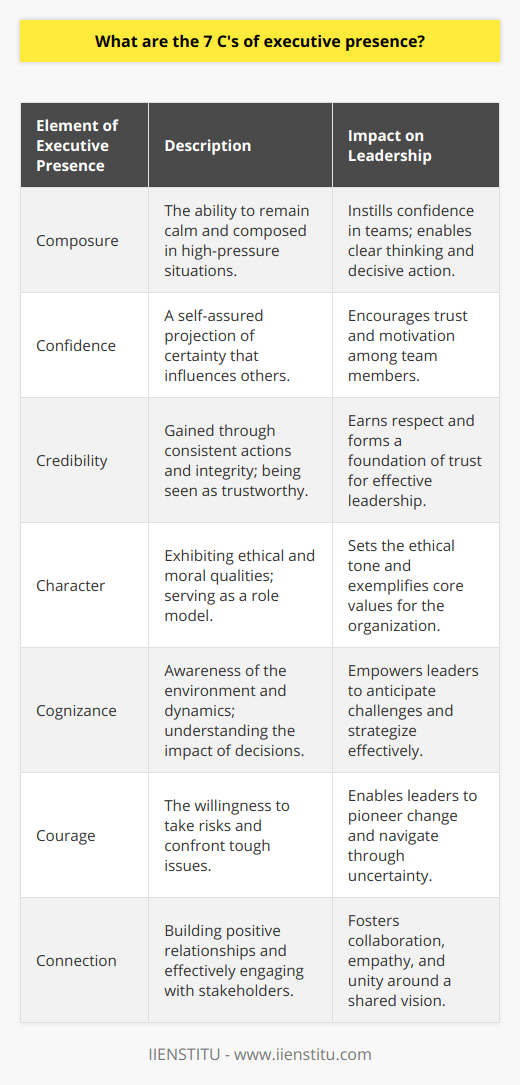
How do you develop a strong leadership presence?
Building a Strong Foundation
Developing a strong leadership presence starts with building self-confidence. Confidence influences how others perceive you, and often, showing confidence fosters respect.
Knowing Your Values
Understand and uphold your core values. Living in alignment with personal beliefs makes your actions authentic. This authenticity allows others to trust and follow you.
Understanding Your Leadership Style
Identifying your leadership style is also crucial. Whether you are an autocratic, democratic, or laissez-faire leader, understanding your style helps you maximize your strengths and work on weaknesses.
Building Key Skills
Fostering communication skills is vital in exhibiting strong leadership. Being able to convey your vision effectively motivates team members. The ability to listen is equally important, ensuring everyone's voices are heard.
Promote Emotional Intelligence
Emotional intelligence is essential in leadership. It helps you understand and respond to team members' emotional needs, enhancing their engagement. It also aids in managing your emotions in challenging scenarios.
Being Decisive
Make difficult decisions wennecessary, to exhibit your leadership presence. Weighing the pros and cons and making well-informed decisions demonstrates your analytical abilities and empowers your team.
Developing Resilience
Adaptability in challenging situations is another indicator of leadership strength. Being resilient helps you navigate changes and uncertainties, fostering trust in your leadership.
Showing Empathy
Lastly, show empathy towards your team members. This builds stronger relationships, increasing their trust in your leadership.
In conclusion, developing a strong leadership presence demands authenticity, effective communication, emotional intelligence, decisiveness, resilience, and empathy. Cultivating these attributes will undoubtedly enhance your leadership capabilities, making you an effective leader whom others look up to and trust.
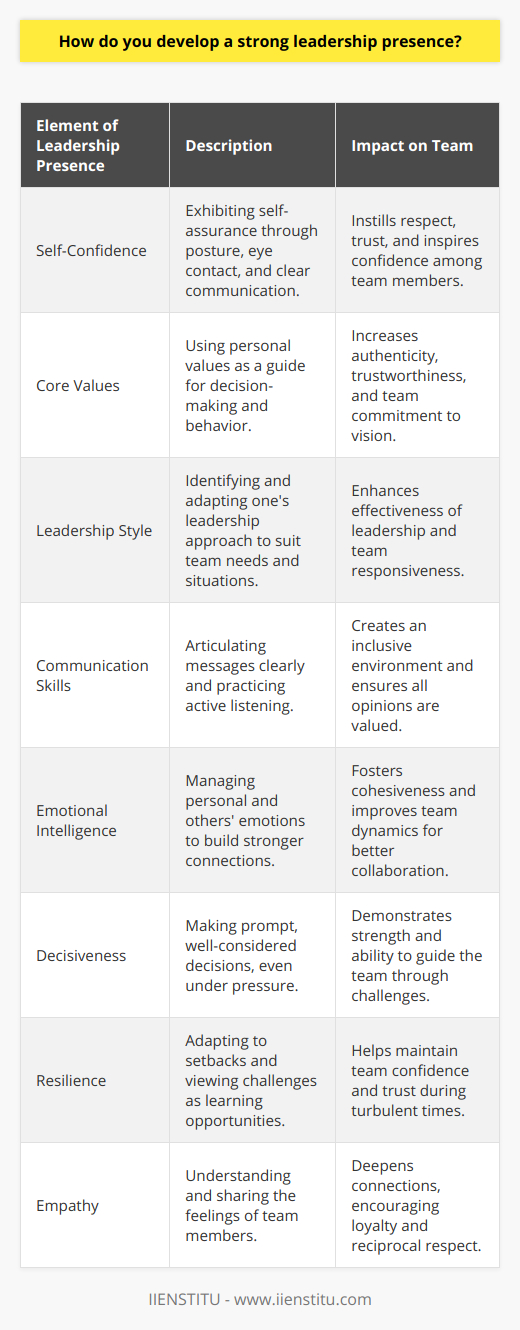
What are the 3 Ps of executive presence?
Understanding Executive Presence
Executive presence refers to the ability of leaders to emanate confidence, poise, and authenticity that effectively influences others. It is usually encapsulated in the three Ps: poise, presence, and projection.
Poise
Executive poise refers to a leader's calm and composed demeanor, which forms the bedrock of executive presence. Highly poised executives ensure consistent, well-balanced reactions to business developments, irrespective of their positive or negative nature. They display resilience, mental strength, and emotional stability while making critical business decisions.
Presence
Executive presence also entails one's ability to command attention when entering a room or communication space. The whole essence of presence is being physically and mentally present, maintaining eye contact, being attentive to details, and respectfully acknowledging others. This ability is multi-pronged, invoking spatial awareness, mindfulness, and the capacity to engage and influence others positively.
Projection
Final component, projection, pertains to how executives communicate their ideas, beliefs, and personal brand. This includes verbal communication, body language, personal appearance, and the overall image they project. Effective projection requires clarity in message delivery, passion, and authenticity to persuade and mobilize others towards a common goal.
In Conclusion
Improving these three Ps can enhance executive presence. However, a balance is essential, as overemphasis on one aspect may undermine the others. A good leader possesses poise to maintain emotional stability, presence to command respect, and projection skills to effectively communicate their vision. Together, they form the triad of effective executive presence.
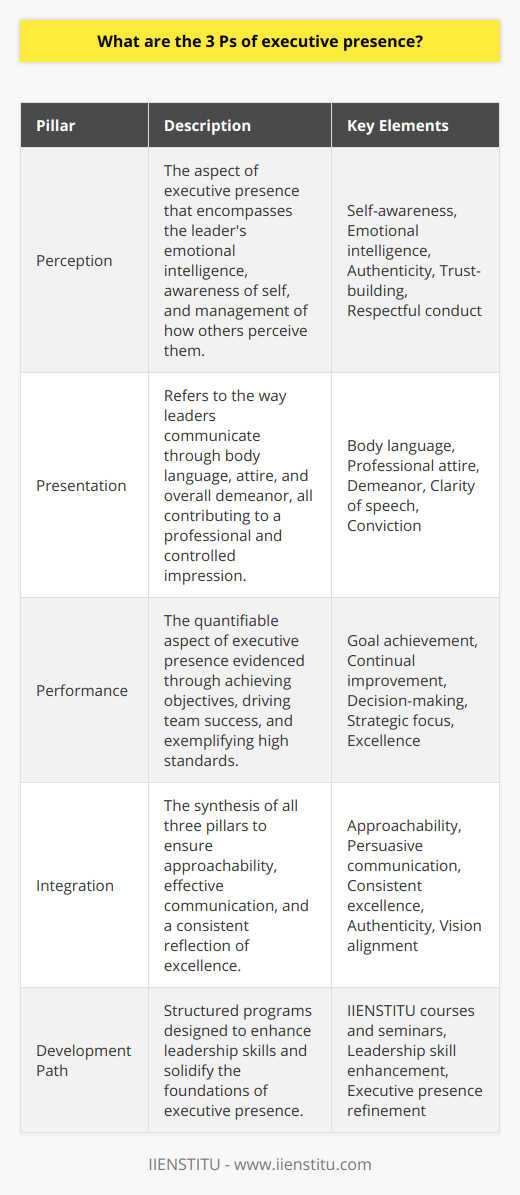
What are the key components of the 5 C's and 7 C's models of leadership and executive presence?
Components of the 5 C's Model
The 5 C’s of leadership and executive presence include Confidence, Credibility, Connection, Communication, and Courage. Confidence refers to a leader's firm belief in their skills and capabilities. Credibility signifies the earned trust through transparency, honesty, and integrity. Connection refers to how a leader establishes bonds and fosters relationships. Communication relays the ability to transmit ideas effectively. Courage exhibits a leader's willingness to take risks.
Elements of the 7 C's Model
The 7 C's model expands on the previous model, introducing two additional elements: Control and Charisma. Control means managing one's emotions, reactions, and being organized and disciplined. Charisma, on the other hand, is the personal magnetism or charm that enables a leader to inspire and attract followers.
Comparison of 5 C's and 7 C's Models
Both models stress the importance of leaders displaying high levels of confidence and being able to connect with their teams on an individual and collective level. Additionally, the models agree on the importance of communication to pass on the vision and direction to team members effectively. The 7 C's model adds control, which is vital in managing various business elements, and charisma, that aids in winning the trust and commitment of the team.
Importance in Leadership and Executive Presence
These models are instrumental in shaping a successful leader and helping to inspire a shared vision. A leader who displays these traits can build a strong, committed team. Moreover, these characteristics enhance the leader's executive presence, making them more influential and effectual.
Overall, the 5 C's and 7 C's models are integral in developing executive presence and leadership. They offer significant insights into desirable leadership traits which not only inspire the team members but also influence the work environment positively. Leaders embodying these characteristics can make strategic decisions while standing firm in the face of adversity.

What are the best strategies for cultivating the 3 P's of executive presence as a leader?
Cultivating Perceptiveness:
The best strategies for cultivating the first “P”, Perceptiveness, as a leader rely heavily on active listening and observation. Active listening means fully concentrating, understanding, responding, and then remembering what someone says. Effective leaders must sharpen their observational skills to decipher non-verbal cues like body language and facial expressions. This improves insight into others' thoughts and feelings, thereby allowing leaders to respond effectively.
Enhancing Presence:
The second 'P', Presence, represents a persons' unique charisma. Leaders can cultivate this by focusing on confidence, open posture, and forging emotional connections. Confidence comes from having thorough knowledge and understanding; familiarizing one's self with all facets of business operations encourages this. Maintaining an open posture while interacting strengthens one's presence and signifies approachability. Lastly, forging emotional connections, recognizing team members as individuals with distinct motivations and working to align these with organizational goals, contributes significantly to presence.
Improving Projections:
For the third “P”, Projections, leaders can employ clear and consistent communication, which is paramount for any leader. This means articulating vision, setting expectations, and giving feedback decisively and constructively. Notably, being open to receiving feedback and making subsequent adaptations is equally important. Additionally, maintaining a positive demeanor, even during challenges, helps sustain positive team morale. Projections are also honed by embodying authenticity and displaying respect to both self and others.
In conclusion, these strategies for cultivating the “3Ps” of executive presence - Perceptiveness, Presence, and Projections – are vital for effective leadership. They require ongoing self-development, feedback, and practice to perfect. However, once honed, they significantly enhance a leader's capacity to inspire, motivate, and guide their team towards achieving organizational goals.
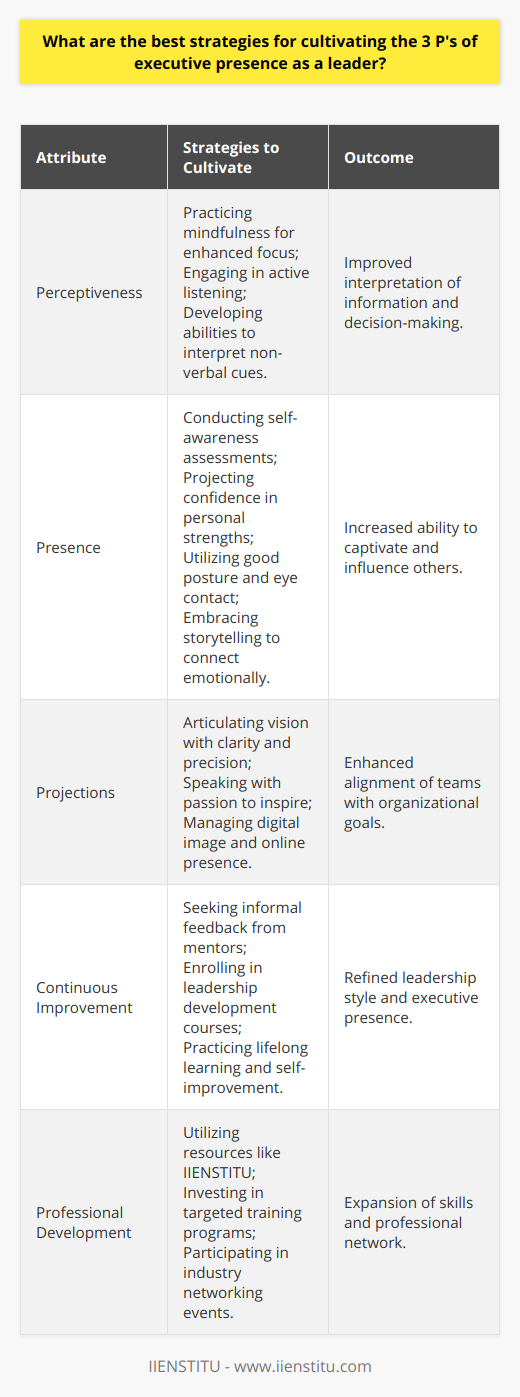
How can one assess and measure improvements in their leadership presence?
Evaluating Improvements in Leadership Presence
Identifying aspects of leadership requires initial self-assessment. Leaders can continually rate their skills in areas like communication, decision-making, and emotional intelligence. These regular appraisals can reveal advancement and areas needing progress.
Skills Assessment Approach
Assessment tools like 360-degree feedback can be valuable. Colleagues and subordinates provide the leader with an honest evaluation from their perspective. This is an effective way to gauge leadership growth as it offers a rounded view of the leader's behavior and impact.
Feedback Assessment Strategy
One can track the frequency and nature of feedback over time. Positive changes in feedback indicate improvement in leadership presence. Similarly, reductions in negative commentary show augments in leadership quality.
Behavioral Changes
Monitoring changes in behavior can also be insightful. Improvements in public speaking skills, for example, are a tangible measure of enhanced leadership presence. Similarly, an increase in confidence when delegating tasks may indicate growth.
Decision-Making Skills
Assessing decision-making abilities is another method. This may come from tracking the outcomes of decisions, how quickly and efficiently they make decisions, and how they deal with uncertainty.
Influence and Impact
Assessing one's influence and overall impact within the organization allows for the measurement of leadership presence enhancements. This could be through measures such as increased followership, more engagement from team members, or a rise in team productivity.
Personal Reflection
Finally, personal reflection plays a crucial role. Through journaling or reflective practices, leaders can track changes in their skill sets, attitudes, and behaviors. This self-analysis is key to understanding the progress in one's leadership presence.
By implementing these varied approaches, leaders can gain a balanced and comprehensive understanding of improvements in their leadership presence. This systematic assessment enables continuous growth, empowering leaders to better serve their organizations.

What are the key elements that contribute to an effective leadership presence?
Leadership Presence
A crucial element contributing to an effective leadership presence is communication. Leaders must express their ideas clearly and persuasively. They should actively listen, encourage open dialogue, and adjust their message depending on the context.
Emotional Intelligence
Next, emotional intelligence is a vital component. Leaders must master the art of recognizing, managing, and using their feelings in beneficial ways. Empathy, the ability to understand and share the feelings of others, promotes active listening and fosters strong relationships.
Authenticity
Furthermore, authenticity strengthens the leadership presence. Leaders must remain true to their beliefs and values, demonstrating consistency between their words and actions. This authenticity can build trust, encouraging cooperation within the team.
Vision and Strategic Insight
The ability to articulate a compelling vision is another key element. Leaders must present a clear and strategic plan, inspiring others to participate actively towards achievable goals. This foresight enhances the leaders’ credibility and influence.
Self-confidence
Finally, self-confidence forms an essential part of a leadership presence. Leaders must display confidence in their ability to meet challenges, make decisions, and solve problems. This self-assuredness can instill confidence in the team, fostering a positive working climate.
In conclusion, effective leadership presence arises from a combination of communication skills, emotional intelligence, authenticity, vision and strategic insight, and self-confidence. These elements foster trust, respect, and cooperation, thereby fostering productive work environments, and ultimately, organizational success.
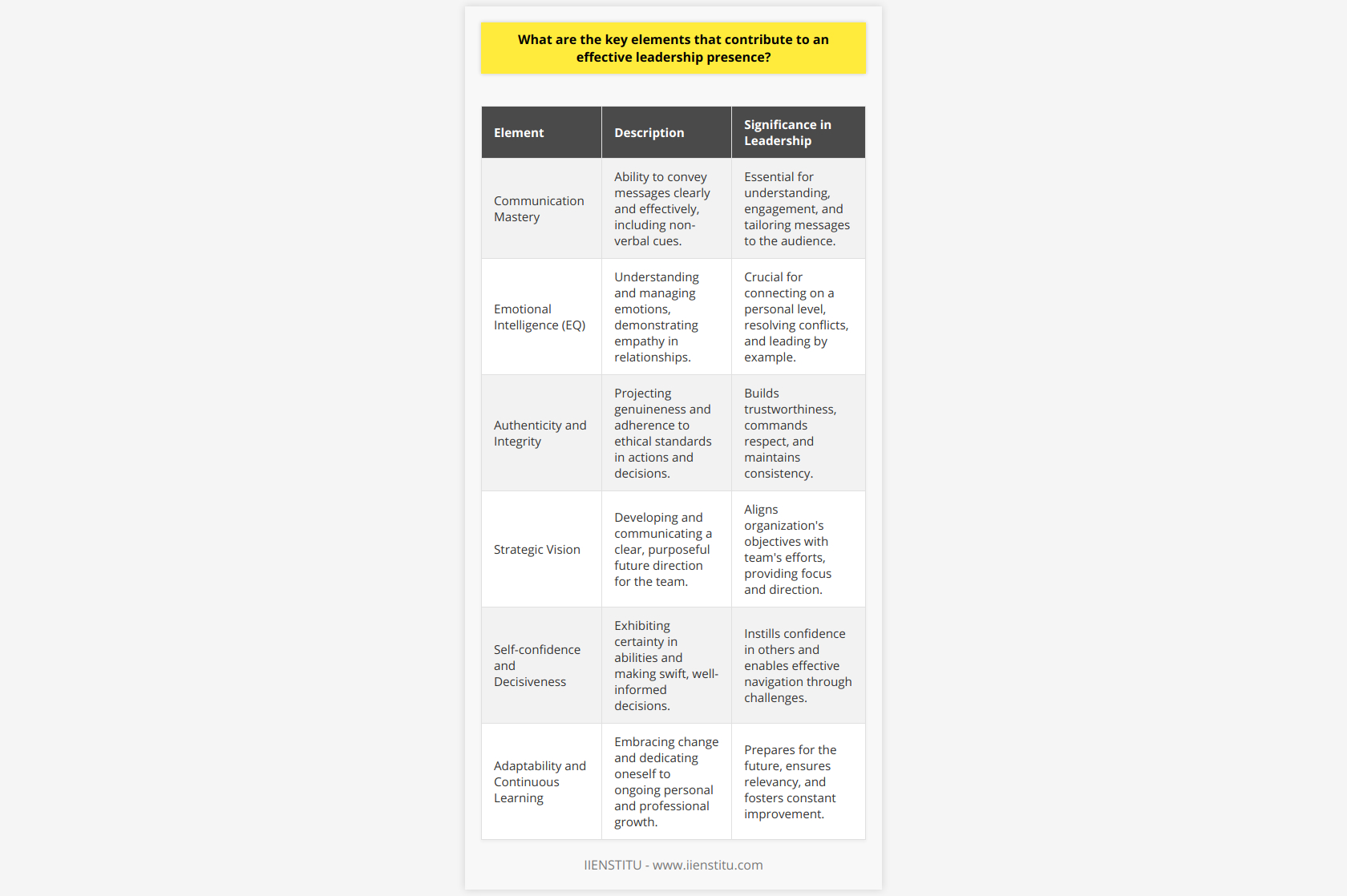
How can the principles of emotional intelligence and effective communication be applied to enhance one's leadership presence?
Understanding Emotional Intelligence
Developing emotional intelligence is a powerful tool to elevate one's leadership presence. Emotional intelligence comprises self-awareness, self-regulation and empathy, which are essential components of effective leadership. Effective leaders can use emotional intelligence to guide their actions and decisions, taking into account both their own emotions and those of their team members.
Cultivating Emotional Intelligence in Leadership
Adopting emotional intelligence into leadership role requires continuous practice. A leader requires self-awareness to understand their emotional responses. In addition, self-regulation helps a leader to keep their emotions under control, particularly during stressful situations. Moreover, empathy enables a leader to connect with their team on a personal level, thereby fostering a better understanding and boosting productivity.
Effective Communication in Leadership
Effective communication is a catalyst for powerful leadership. It incorporates clear expression of ideas, active listening, timely feedback and open-mindedness. A leader who communicates effectively ensures that their team understands the directives and goals with clarity. Additionally, effective communication fosters a conducive environment for feedback, encouraging the team members to voice their opinions.
Building Effective Communication Skills
Leaders can improve effective communication by actively listening to their team members. This includes acknowledging their ideas and providing constructive feedback. Open-mindedness in accepting criticism is also a crucial aspect of effective communication. It helps in demonstrating the respect for diverse opinions and improves problem-solving skills.
Conclusion
Incorporating emotional intelligence and effective communication principles in leadership significantly enhances one's presence. These concepts articulated into action create a positive environment, foster stronger relationships and boost productivity. Therefore, constant upskilling in these areas is key for leaders aiming at enhancing their leadership presence.
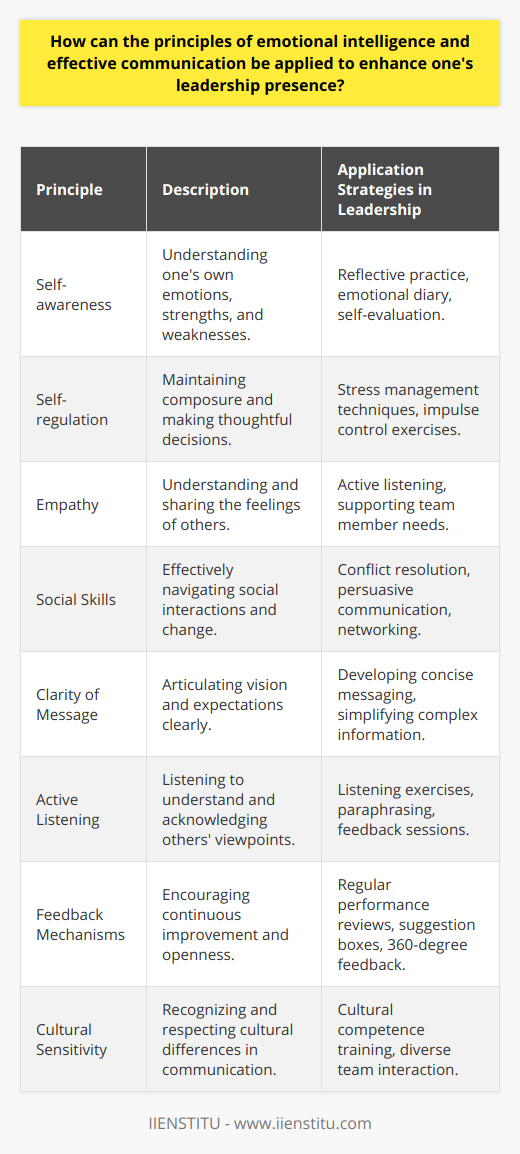
In what ways can a leader's self-awareness and authenticity positively impact the development of their leadership presence?
Implications of Self-awareness
A leader's self-awareness can drive their leadership presence in numerous ways. First, self-aware leaders understand their strengths and weaknesses. This understanding guides them to delegate tasks to those more skilled than they are in certain areas. As a result, this reinforces trust within their team, enhancing the leader's presence and influence.
Authentic Leadership and its Perks
Moreover, authenticity in leadership contributes tremendously to developing leadership presence. Authentic leaders remain true themselves, further preserving their integrity and legitimacy. They consistently show their genuine character, allowing for a clearer communication channel and thus an increased sense of trust among their team members.
Impacts on Followers
This transparent, honest approach not only motivates the followers but also inspires them. They see the leader as approachable and reliable. In turn, this boosts team morale and productivity.
Enhancing Group Dynamics
Importantly, such leaders can handle conflicts more effectively. Their clear understanding of both personal and team dynamics, harboured by their authenticity and self-awareness, aids in finding constructive solutions.
Conclusion
In conclusion, a leader's self-awareness and authenticity substantially influence their leadership presence. These aspects encourage trust, clarify communication, inspire followers, and foster productivity, thereby reinforcing a positive leadership environment.



